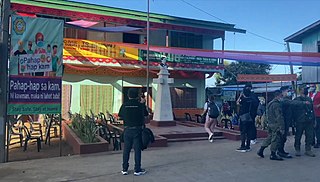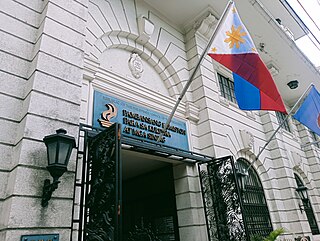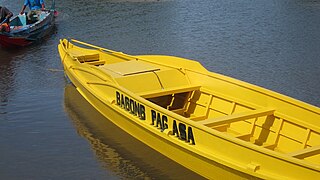Related Research Articles

Sulu, officially the Province of Sulu, is a province of the Philippines in the Sulu Archipelago.

Tawi-Tawi, officially the Province of Tawi-Tawi, is an island province in the Philippines located in the Bangsamoro Autonomous Region in Muslim Mindanao (BARMM). The capital of Tawi-Tawi is Bongao.

The Autonomous Region in Muslim Mindanao was an autonomous region of the Philippines, located in the Mindanao island group of the Philippines, that consisted of five predominantly Muslim provinces: Basilan, Lanao del Sur, Maguindanao, Sulu, and Tawi-Tawi. It was the only region that had its own government. The region's de facto seat of government was Cotabato City, although this self-governing city was outside its jurisdiction.

Bongao, officially the Municipality of Bongao, is a 2nd class municipality and capital of the province of Tawi-Tawi, Philippines. According to the 2020 census, it has a population of 116,118 people.

Mapun, officially the Municipality of Mapun, is a 4th class municipality in the province of Tawi-Tawi, Philippines. According to the 2020 census, it has a population of 30,038 people.

Sitangkai, officially the Municipality of Sitangkai, is a 1st class municipality in the province of Tawi-Tawi, Philippines. According to the 2020 census, it has a population of 37,319 people.

South Ubian, officially the Municipality of South Ubian, is a 3rd class municipality in the province of Tawi-Tawi, Philippines. According to the 2020 census, it has a population of 29,583 people.

Tandubas, officially the Municipality of Tandubas, is a 2nd class municipality in the province of Tawi-Tawi, Philippines. According to the 2020 census, it has a population of 34,316 people.

The National Commission for Culture and the Arts of the Philippines is the official government agency for culture in the Philippines. It is the overall policy making body, coordinating, and grants giving agency for the preservation, development and promotion of Philippine arts and culture; an executing agency for the policies it formulates; and task to administering the National Endowment Fund for Culture and the Arts (NEFCA) – fund exclusively for the implementation of culture and arts programs and projects.

Bangsamoro, officially the Bangsamoro Autonomous Region in Muslim Mindanao, is an autonomous region in the Philippines, located in the southwestern portion of the island of Mindanao.
Intangible cultural heritage (ICH) includes traditions and living expressions that are passed down from generation to generation within a particular community.

Tiririt, also known as taririt or papet, is a type of small dinghy of the Sama-Bajau and Tausug people of the Philippines. It is commonly motorized. It is usually carried aboard larger motherships and assists in transporting passenger and cargo to the shore, as well as in towing the boat to port. However, it can also be used as a small inter-island transport. It is roughly leaf-shaped in outline with a distinctive hump-backed side-profile. The prow and stern can sometimes rise up into arcs. It normally has no outriggers.

Ambalang Ausalin was a Filipino master weaver from the city of Lamitan, Basilan.
The 2025 Bangsamoro Parliament election is scheduled to take place in the Bangsamoro Autonomous Region in Muslim Mindanao (BARMM) on May 12 under the Bangsamoro Organic Law, the charter of the autonomous region of the Philippines.

Abina Tawide Coguit is a Filipino textile master weaver
Marife Ravidas Ganahon is a Filipino mat weaver known for the Higa-onon Manobo mat weaving art of ikam.
Amparo Balansi Mabanag is a Filipino beadworker and embroider.

Samporonia Pagsac Madanlo is a Filipino artisan known for the dagmay weaving.
Barbara Kibed Ofong is a Filipino master textile weaver who specialize in T'nalak.
Rosie Godwino Sula is a Filipino chanter, musician, composer, and dancer.
References
- ↑ "Parliament Resolution No. 490" (PDF). 2nd Bangsamoro Parliament. December 22, 2023. Retrieved November 15, 2024.
- 1 2 3 "Preserving traditions: Tawi-Tawi native honored with national Manlilikha ng Bayan Award - BARMM Official Website". Bangsamoro Information Office. January 4, 2024. Retrieved November 15, 2024.
- 1 2 3 Manipon, Roel Hoang (January 1, 2024). "Hail the newly declared National Living Treasures". Daily Tribune Lifestyle. Retrieved November 15, 2024.
- ↑ "Pagbati sa ika-70 na kaarawan ni Manlilikha ng Bayan Hadja Sakinur-ain Delasas" [Greetings for the 70th birthday of National Living Treasure Hadja Sakinur-ain Delasas]. Instagram (in Filipino). National Commission for Culture and the Arts. Archived from the original on November 15, 2024. Retrieved November 15, 2024.
- ↑ "9 'Manlilikha ng Bayan' named". Philippine Daily Inquirer. December 22, 2023. Retrieved November 15, 2024.
- ↑ Parungao, Adrian (December 23, 2023). "BARMM lawmakers file reso to recognize traditional dance artist Hadja Sakinur-Ain Mugong Delaslas' contributions". Philippine Daily Inquirer. Retrieved November 15, 2024.